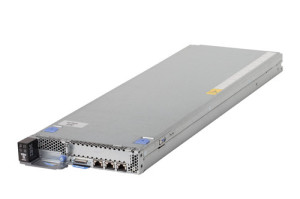IBM is working to develop microservers based on low-power processors but isn’t sure yet when the systems will be introduced.
The company has already built a prototype board that could function as microserver but has yet to determine what workloads it would be used for, said Gaurav Chaudhry, IBM worldwide marketing manager for System x high-performance computing.
Dozens of microservers packed into a chassis could reduce energy use, space requirements and cost compared to a smaller number of traditional 1U or 2U servers, he said, but IBM is still researching the systems and figuring out who would be the target audience.
After a few delays, Hewlett-Packard launched its first Moonshot server earlier this year and recently updated it with Intel’s newer Avoton chips. The server is aimed at Web-scale workloads and HP claims Moonshot is 90 percent more energy-efficient than a more traditional Proliant DL380 server.
IBM, not surprisingly, says it’s determined to do better. “We want to go out and beat the competition,” Chaudhry said.
While it works toward microservers, the company is also introducing other types of high-density server design.
On Tuesday it introduced the NextScale System, a rack server system that can accommodate up to 84 x86-based systems and 2,016 processor cores.
One component of the rack is the NeXtScale n1200, a 6U enclosure that can hold up to 12 NeXtScale nx360 M4 servers. Each NeXtScale nx360 M4 server will be able to host up to two processors, up to 256GB of RAM, two hard drives or four solid-state drives. The server is targeted at analytics, databases and technical computing.
The 6U enclosures can share cooling resources and power supplies, reducing power costs.
“You cut down on the number of power supplies … and double the density,” Chaudhry said.
The first NextScale System will be based on Intel’s Xeon E5-2600 v2 chips, which were announced Tuesday at the Intel Developer Forum and are based on the Ivy Bridge architecture. The new server chips, based on the Ivy Bridge processor, will have up to 12 cores and draw between 70 watts and 130 watts of power.
“The whole idea is there are different people who have different requirements. Cloud guys don’t care about a ton of compute, they care about density,” Chaudhry said.
Each server board has its own storage and network components and connects directly to the top of the rack for networking. Other components, such as graphics processors, can be attached to a PCI-Express 3.0 slot, and a mezzanine card can bring different types of networking such as InfiniBand into the servers.
“We thought a lot about it. Turns out 6U is the optimal space for many things that we can do to satisfy the industry requirements,” Chaudhry said
The NextScale chassis is flexible and could be extended to microservers in the future, Chaudhry said, adding that IBM didn’t want to have to go back and design a different chassis when its microservers come out.
The Ivy Bridge-based NextScale System will start at US$4,049 and vary in price based on configuration, IBM said.





